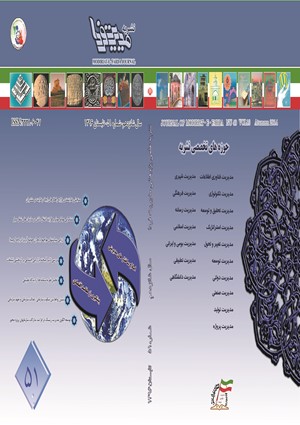-
-
List of Articles
-
Open Access Article
1 - Developing the Roadmap of Succession Planning in the Organization (Case study: Iranian Gas Transmission Company, district 3)
Mostafa Najafi Sharafeddin Mohammad arazi Aliakbar Hasani -
Open Access Article
2 - Effective organizational elements and the results of cross-functional coopetition in small and medium size industries
Hossein Rahmanseresht bahram jabarzadeh karbasi -
Open Access Article
3 - Exploring Content of Nurses’ Emotional Labour Dimensions and Investigating the Impact of Human Resource Management Practices on it in Mashhad’s Public Hospitals
Mostafa Kazemi saeed mortazavi -
Open Access Article
4 - Motion Algorithm from EFQM toward BSC in order to prioritize improvement projects of self- assessment.
mohammad saleh owlia mohammad hosein abooie پرستو دمرچی -
Open Access Article
5 - Design and offering conceptual model of investigation impact of strategic entrepreneurship on strategic innovation in knowledge-based firms of Bushehr provience
fakhrieh Hamidianpour mahboobe shafiei مریم دهقانی -
Open Access Article
6 - The Role of Agile Manufacturing in Improving Organizational Productivity
gholamreza hashemzade khorasegani Mohammad Reza Bahrami -
Open Access Article
7 - The Effect of Brand distinctiveness and performance on Brand Competitiveness with the Mediating Role of Technological Opportunism
Davood Feiz Ali Reza Motameni Asadolah Kordnaeij Azim Zarei Mahdi Dehghani Soltani -
Open Access Article
8 - Explaining the Patterns of Excellence in Excellence for Activist Organizations
Maryam Gholizadeh -
Open Access Article
9 - Identify and Prioritize indicators Of Knowledge-Based Soft Technologies Case Study:Computer Games
Alireza Aliahmadi Tahereh Barideh -
Open Access Article
10 - Identifying and evaluation the effective factor on successfully implementation of ERP in Small and Medium-sized Enterprises with emphasis on the life cycle of this system (Case Study: Enterprises located in the industrial town of Rasht Sefidroud)
Marzieh Babaeianpoor -
Open Access Article
11 - Identification and analysis of the affecting factors on the success of technology road mapping by using interpretive structural modeling technique
Afsaneh Ahmadi Seyed Sepehr Ghazinoory Fatemeh Saghafi -
Open Access Article
12 - Work-life quality and organizational performance, using the Balanced Scorecard (Case Study: University of Science and Technology)
saeed khademian hamed dehghanan -
Open Access Article
13 - استراتژی مسیریابی و زمان بندی بهینه وسایل امدادی برای تخلیه افراد سالم در شرایط بحران
مهدی حیدری fatemeh sabouhi ali bozorgi amyri -
Open Access Article
14 - Stuyding the relationship between assertiveness and empathy of faculty members who have managerial positions (case study:Valiasr university of Rafsanjan)
marzieh kahnooji -
Open Access Article
15 - Design human resource strategy according to jobs grouping in Tehran UAST
seyed aliakbar ahmadi freshte amin مجتبی کاتب reza rasouli -
Open Access Article
16 - Explanation of Human Resource Development Model Based on Islamic-Iranian Model
vahid nasehi far saeid Askari Masule
-
The rights to this website are owned by the Raimag Press Management System.
Copyright © 2017-2025







